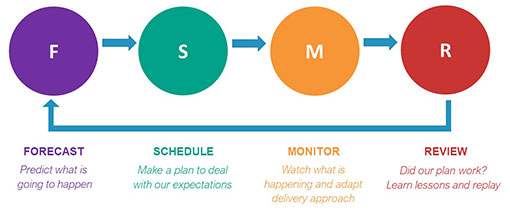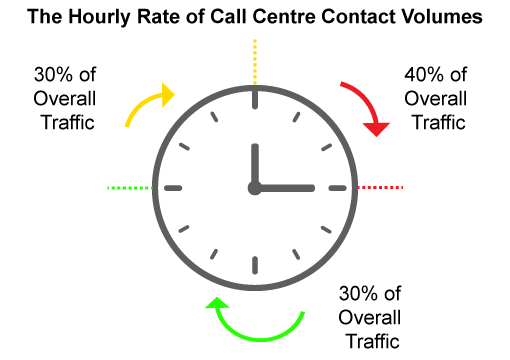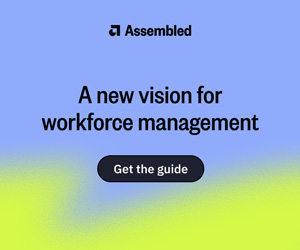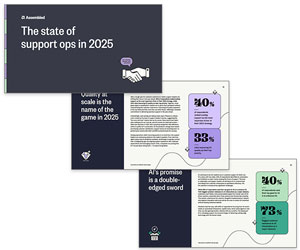WFM planning is a critical component of managing a contact centre efficiently, ensuring that the right number of agents with the right skills are available to meet customer demand.
We introduce you to the fundamentals of workforce planning, before setting out 20 key rules that every contact centre planner should know.
The Planning Cycle
There are four key parts of workforce planning, as highlighted below in “the planning cycle” (also known as the the WFM cycle), which was shared with us by WFM expert John Casey in our article: Resource Planning: What You Need to Know
Each of these four key parts of the planning cycle is highlighted in the graphic below:

Of course there are other duties of a workforce planning professional in the contact centre, and lots of new channels, techniques and tools entering the field, but this cycle remains as important as ever.
With this in mind, let’s explore each of the areas a little further and present some golden rules for each, which will really help you to maximize your workforce planning performance.
Forecasting
The first stage of our workforce planning cycle is forecasting. This is where we predict contact volumes, based on trend and seasonality.
With this in mind, let’s look at some of the rules good workforce planners stick by when trying to make the best possible contact volume predictions.
1. Create at Least Three Forecasts, Not One
As John Casey of CCplanning once told us: “We shouldn’t be guessing what might happen in order to make a forecast based on this estimation. To be fully prepared, we need to be making multiple forecasts.”
All of our forecasts will have a certain amount of uncertainty within them, so we need to be prepared and to understand what’s going on…
We’ve got to prepare for what might happen. All of our forecasts will have a certain amount of uncertainty within them, so we need to be prepared and to understand what’s going on – within our company and all of the various outside influences.
There will be situations that we wouldn’t have thought of if we’d created forecasts three or six months ago.
So, we want to create upper-, middle- and low-level forecasts that represent various scenarios that will change why and how many customers want to call us.
2. Analyse Outliers in Your Historical Contact Volumes
We want to remove outliers from our contact history, so that they don’t influence future forecasts, but the trick is knowing when and what to remove.
“You need to analyse what you are going to remove, because you don’t know what is an outlier and what may be becoming a business as usual pattern,” adds John Casey.
So, we need to analyse outliers, so we know:
- Why they happened
- What impact they had
- Are they happening on a regular basis?
But our final point here is that, if you are removing outliers, don’t forget to remove the short ones as well as the top-end long ones, when looking at call length.
3. Aim to Forecast in 15-Minute Intervals
The general aim of forecasting is to make it as granular as possible. This means forecasting down to 15 minutes, if possible, so we can better match our workforce to our workload.
Also, this will help us to avoid the situation where we meet our overall service level target, but have really bad dips in service levels throughout the day.
Yet, this is not always a golden rule. If we are 30% out on the week in terms of forecast accuracy, there’s not much point in trying to get down to 15-minute intervals.

Dougie Cameron
“At this point, you just want to work on hours and days because, otherwise, all you’ll be doing in making the error even bigger in the 15-minute intervals,” says Dougie Cameron, COO at The Centre for the Moving Image.
So, if you’re in this position, the main focus is trying to get your overall accuracy better rather than worrying about how granular you go, but generally 30 minutes is a minimum.
Just remember, though, that you can only use 15-minute intervals if your AHT is less than seven and a half minutes, otherwise overhang can be a problem.
4. Be Aware of the Impact That Other Departments Have
In the contact centre, we should be owning as much of the workforce planning as possible, and this is especially true when it comes to forecasting.
We want to do this because it makes root cause analysis easier, so we can improve forecast accuracy. However, other departments should have a role within the forecasting process.
We want to do this because it makes root cause analysis easier, so we can improve forecast accuracy.
As Ralph, one of our readers, says: “Getting better inputs from marketing around campaigns and working closely together with finance to have the best possible distribution of bills and reminders is critical.”
So, our goal is to create our forecasts with these valuable inputs and to own that process. We can then pass it on to other departments for further refinement, if needs be.
5. Remember, 100% Forecast Accuracy Is an Unrealistic Goal
Consistently achieving 100% forecast accuracy is not a realistic aim. It is therefore better to aim for a steady level that is close to 100%. After all, we don’t want to become so fixated on this goal that we lose sight of customer and employee implications.
Also, we don’t want to be constantly testing new ways of reaching 100% forecast accuracy in a “live environment”. The risks are too big.
“The best test of forecast accuracy is going back in history and trying to reforecast the future, as that will be the ultimate test of whether your model is better,” says Dougie Cameron.
This will allow us to experiment with the latest forecasting models in a safe environment, as we test improved ways to reach a consistently good forecast accuracy.
For more on how to test and improve your contact centre forecasts, listen to the following episode of The Contact Centre Podcast, with Doug Casterton, a senior WFM manager.
The Contact Centre Podcast – Episode 22:
Resource Planning Advice To Boost Efficiency And Engagement
For more information on this podcast visit Podcast – Resource Planning Advice to Boost Efficiency and Engagement
Scheduling
Once we have forecast contact volumes, we need to plan and schedule the right number of advisors to meet our predicted demand.
We also need to map our staffing calculations against shift patterns that are both efficient and engaging. This all happens at the scheduling phase of our workforce planning cycle.
6. An Erlang Calculator Is Your Go-to Staffing Tool
With your forecast contact volumes, it is now time to calculate how many staff you need across the day. Many contact centres use an Erlang Calculator and spreadsheets for this.
While some larger contact centres will use complex workforce planning systems, the Erlang Calculator remains a trusted tool – particularly for those contact centres with fewer than 30 advisors.
To use an Erlang Calculator, you simply insert the following information:
- Forecast number of calls
- Length of forecasting interval (minutes)
- Average Handling Time (seconds)
- Target Service Level (%)
- Target Answer Time (seconds)
- Target Occupancy Rate (85%)
- Shrinkage (%)
- Average Patience (seconds)
By following this process across the course of the day, you can calculate your staffing requirements and fit them into your preferred shift patterns.
For more on choosing the right shift patterns, read our article: The Best Shift Patterns for the Contact Centre
7. Calls Will Flood in Just Before and After the Hour Mark

Dave Appleby
“In life, people have lunch breaks, meetings and finish watching television right on the hour mark – so, in the contact centres that I’ve worked in, we have seen a lift in calls just before and after the hour,” says Dave Appleby, a workforce planning expert at Appleby Technical.
We can see this generic pattern presented below:

If you see this pattern in your contact centre, the key learning is to make sure that your shift starts are well in advance of the hour, to make sure people are present, sitting down and logged in for when that hourly peak arrives.
Other patterns that you may want to look out for in both your scheduling and forecasting are that Monday tends to be the busiest day of the week and 10am–12pm will likely be your busiest time of day.
8. Shift Patterns Are Often Best Built Around Common Lifestyles
Our schedules only work well if advisors stick to them, but absence and attrition are such big issues in most contact centres that our workforce planning is negatively impacted.
While we can forecast both of these metrics to some extent too – and apply that to our schedules – a better approach is to design shifts that people want to work, so it gives them a good work/life balance.
We can then target certain lifestyles in recruitment or at least use classic WFM tricks like offering advisors the chance to choose one time in the week where they don’t have to work, to better accommodate their lifestyle.

Doug Casterton
However don’t only rely on lifestyle scheduling to reduce attrition and absenteeism.
Doug Casterton warns us: “It’s hard to maintain, and if you ever get into a situation where you’re not backfilling your attrition, you could potentially create gaps in your schedule cover. So, look at it holistically and have strategies to fill different needs.”
For more on reducing attrition and absence, read our article: 29 Strategies to Tackle Agent Absence and Attrition
9. Keep Measuring Your Schedule Efficiency and Inflexibility
As with anything, if we don’t have a measure, how will we know how good a job we are doing? Scheduling is no exception.
Yet, as John Casey tells us: “Almost have of contact centres don’t measure schedule efficiency, which isn’t good because we always must have a tracker on our schedules. We need to know what we are delivering against what we actually needed.”
Just look at the table below. If we look at the day as a whole, we have exactly the right number of staff, but – at each individual hour – our calculations were wrong.
| Time | Required | Delivered | Difference | Absolute Difference |
|---|---|---|---|---|
| 09:00 | 32 | 30 | -2 | 2 |
| 10:00 | 36 | 39 | 3 | 3 |
| 11:00 | 38 | 39 | 1 | 1 |
| 12:00 | 42 | 39 | -3 | 3 |
| 13:00 | 38 | 39 | 1 | 1 |
| Net Difference | 0 | 10 | ||
| % Difference (MAPE) | 0.0% | 5.4% |
This is why we need to measure scheduling efficiency to gain this clear picture.
Another good metric to calculate is schedule inflexibility. Schedule inflexibility tells us how much inflexibility is inherent when we create a schedule that is not able to perfectly cover demand as a forecast.
10. Understand the Human Behaviours Behind Schedule Adherence
For many contact centre professionals, schedule adherence is the key ingredient in advisor productivity calculations. But it’s a tricky topic.
While adherence is important, we need to implement flexibility levers that go beyond the numbers. We need to understand the human behaviours that sit behind the data.
If we can understand why things are happening, we will be able to address schedule adherence problems and minimize the negative impact it has on our schedules.
If we can fit this into of defining our adherence measure, determining root cause and applying behavioural solutions to address the issue, we can create greatly improve the success of our schedules.
Monitoring
A key part of workforce planning is to proactively manage queues across all channels, to ensure that service levels, occupancy rates and other business targets are being met.
When monitoring these things in real time, a workforce planner may have to action recovery plans – if contact volumes are unexpectedly high or low – to lower the impact of performance threats to contact centres.
11. Create Standard Operating Procedures
Standard Operating Procedures (SOPs) are a set of guides that tell you what to do if contact volumes are unexpectedly high or low. They help to ensure everyone’s on they same page.
We don’t want to be thinking on the spot when service levels plummet, we want to plan and engage ahead of time. This is what SOPs allow us to do and they can be updated every time they are used. This will ensure that, over time, we perfect our emergency response.
Make sure that you articulate in your SOPs the roles that each person plays in addressing the problem. This means that you don’t need to seek permissions to enforce emergency actions…
The other thing to make sure that you articulate in your SOPs is the role that each person plays in addressing the problem. This means that you don’t need to seek permissions to enforce emergency actions – everyone knows what they’re doing, it has been pre-agreed!
“By doing this, we build confidence and remove surprises – so everyone is aware of the duties of the real-time team. Removing this ambiguity is important,” concludes Doug Casterton.
For advice on how to create a Standard Operating Procedure, read our article: How to Write a Standard Operating Procedure (SOP)
12. Communicate Regular Updates of Your Workforce Planning
When working in real time, the contact centre should have processes in place to support workforce planning to input real-time absences and other variations into their WFM plans.
We know that clear reporting processes, coupled with clear roles and responsibilities, are at the heart of monitoring and acting in real time.
In terms of roles and responsibilities, we want to ensure that the workforce planner has the authority to make the necessary changes to protect service, in the way that only they can.
13. Short-Term Tactics May Cause Long-Term Problems
An experienced workforce planner will be cautious over using short-term tactics to maximize service level, as there may be longer-term issues that impact customer experience.
For example, you could choose to realign your contact routing to push certain contact types to advisors who you know will handle that contact quicker.
However, Doug Casterton warns: “The long-term harm of doing that is that while they become and continue to be proficient, nobody else learns – so you isolate your learning to certain segments of your contact centre.”
There may also be the issue that just because advisors handle certain contacts quicker, it doesn’t mean that they do it better, so you may have First Contact Resolution (FCR) issues down the line too.
14. Avoid Knee-Jerk Decisions
Arguably, the greatest skill of a real-time workforce planner is having the ability to hold their nerve. Intuition can be just as valuable as an algorithm in workforce planning.
For example, a good real-time planner will avoid knee-jerk decisions like moving the problem.

John Casey
As John Casey explains: “We see the queue, so we push back lunch and breaks, but those lunch and breaks don’t go away – so later we’ll be understaffed when people do go for their breaks, even if contact volumes are no higher than expected.”
Even in other situations where it may be mathematically correct, your team need stability and human empathy. This is why it’s important to remember your customer, employee and business needs whenever you make an important workforce planning decision.
For more on the danger of not being able to hold your nerve in the contact centre, read our article: Create Room to Breathe Instead of Making Knee-Jerk Reactions
15. Occupancy Shouldn’t Go Above 85%
There are many key metrics to keep an eye on in real time, including service level, queue time and real-time abandon rate, to name just a few.
But occupancy is one of the more important metrics – too often forgotten about – that should be added to your list, as this gives an “in the moment” view of the advisor experience.
We shouldn’t be exchanging high occupancy for low service level, as this will badly damage morale…
We shouldn’t be exchanging high occupancy for low service level, as this will badly damage morale, so we need to build it into our staffing calculations – but it should also be monitored in real time.
Of course, it will peak above 85% from time to time, but if this is something that’s constantly happening, take the hit on queue time and bear it in mind when you move on to the workforce planning review phase…
Reviewing
The day is now over, giving the workforce planning team time to get to grips with whether or not their forecasting, scheduling and monitoring strategies have worked.
With these lessons learned, they can start to identify recurring problems that they are seeing within their WFM plans and address them, in order to continually improve.
16. Review Your Forecasts Against Your Tolerance
One point that we made earlier is that it is impossible to consistently achieve 100% forecast accuracy. But we should set a tolerance so we only allow ourselves to be 5–10% off that mark, at the very most.

Vatsana Gordon
So, go back to reviewing daily, weekly and monthly volumes and check that you met your target of only being 10% off – or maybe even set a tolerance lower than that, if you have confidence in your model.
As Vatsana Gordon, a resource planning expert, once told us: “You should know in your budget models that you have a 5–10% buffer available from an overtime perspective, which means that you should be covered for those peaks and troughs.”
17. Re-optimize Your Schedules
In many contact centres, schedule plans are put together well in advance but they are not considered holistically again. Only small changes are made.
We need to review schedules to see whether we can restructure advisor breaks and coaching sessions.
Yet, just as we review our forecasts, we need to review schedules to see whether we can restructure advisor breaks and coaching sessions.
After all, we want to make the best possible use of our team, from both an efficiency and engagement perspective, and minimize overtime cost.
This is where the skill of curiosity really shows its value, according to Doug Casterton: “Continuous learning is driven by somebody’s curiosity. You can build a development plan or send somebody on a course, but if they are not curious, they won’t absorb much of it and they won’t apply it. So, natural curiosity is invaluable at this review stage.”
18. Evaluate Your Demand Drivers
To perfect our workforce planning, we need to look beyond what is happening and ask ourselves why. This involves analysing our demand drivers in this review period.
When doing this we want to assess the impact of each demand driver (if possible) and how far ahead we can predict that it will impact our forecasts.
By considering this, we can improve our workforce planning strategy by assessing how we can add flexibility to meet our predicted volatility.
19. Reconsider How Far in Advance You Publish Your Shifts
This is too often a forgotten part of workforce planning, but the further in advance you can publish advisor schedules, the happier they will be – as they can better plan their lives.
However, there are many considerations to think about before you decide on when to publish. These are guided by the success of your previous resource planning.
For example, some of these considerations will include:
- Do we have enough confidence in our future forecasts?
- Does everyone need the same notice?
- Can we predict absenteeism and lateness in advance?
Just think about whether giving the team more notice of their shifts is feasible or if you could instead give them other guarantees, such as annual leave within a couple months’ notice.
For more on this topic, read our article: How Far in Advance Should You Publish Your Contact Centre Shifts?
20. Revaluate Your Understanding of Time to Competency
Much of your time in the review phase of the workforce planning cycle will be spent analysing essential WFM metrics, but one that you may not consider is “time to competency”. This is, however, important.
Time to competency is an average measure of how long it takes a new advisor to perform at the level that the contact centre expects. Improving this metric has great productivity benefits.
Time to competency is an average measure of how long it takes a new advisor to perform at the level that the contact centre expects.
If you can trial different methods to optimize contact centre training, such as splitting coaching time into smaller chunks and intersperse time out on the floor learning from senior advisors, you can improve this metric.
By doing so and reviewing your progress, you can better ensure all advisors are performing at the level required, so you don’t have to make special allowances within your planning cycle.
Final Thoughts
While there are other areas of workforce planning to consider, forecasting, scheduling, monitoring and reviewing are the bread and butter of the field.
Within these four key areas of workforce planning there are many rules to stick by, and this article includes 20 really important examples.
Hopefully, you’ll be sticking to many of them already, but if you’re not, try some of them out and you should see a big, positive difference.
Good luck!
For more helpful advice on improving your contact centre’s workforce planning, read our articles:
- Workforce Management Reference Guide
- 50 Expert Tips to Improve Contact Centre WFM
- 50 MORE Expert Tips to Improve Contact Centre WFM
Author: Jonty Pearce
Reviewed by: Hannah Swankie
Published On: 6th Oct 2022 - Last modified: 13th Aug 2025
Read more about - Workforce Planning, Dave Appleby, Doug Casterton, Dougie Cameron, Editor's Picks, Forecasting, John Casey, Real-Time Management, Scheduling, Vatsana Gordon, Workforce Management (WFM), Workforce Planning





















